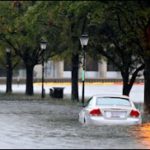
by James C. Sherlock
Virginia is suing FEMA over its new risk rating methodology for the National Flood Insurance Program (NFIP).
Virginia’s suit says that the new methodology:
doesn’t recognize many mitigation efforts, nor does it clearly explain how rates are calculated based on mitigation efforts. This means that (Virginia’s) mitigation efforts don’t result in lower premiums for policyholders.
The suit does not state that the rates are not high enough. Which they are not.
- The costs of repair and rebuilding have soared;
- Sea level rise combined with subsidence is both measured and forecast to increase flood hazards on Virginia’s coasts.
The rest of the country does not “owe” a discount on flood insurance to those of us that choose to live in flood-prone areas.
Rate payers need to cover the costs of the NFIP, including building a reserve – like a real insurance program.
At least three additional issues are pertinent:
- Virginia’s mitigation efforts do not represent a serious attempt to make a difference in mitigation of historic, much less future, hurricane storm surges on our coasts. See the Great Chesapeake-Potomac Hurricane of 1933. Norfolk’s downtown was six feet underwater in 1933, and there have been several feet of sea level rise and subsidence since then;
- NFIP is functionally bankrupt. It owes the Treasury $25 billion that can only be repaid with higher rates. So coastal state lawmakers want it written off. That is a match to their position on raising rates; and
- The NFIP subsidizes risky properties along the coast by charging them below-market premiums. Indeed they advertise to get them to join the program.
NFIP premiums need to cover the projections of payouts and the building of a reserve. I hope that Virginia is only arguing how rates are calculated and distributed, not that they should not go up.
Congress must reauthorize the NFIP by no later than Sept. 30, 2023. I’m going out on a limb and predict they’ll kick the can.
Then again, money is no object in Washington. Maybe they’ll create federal fire insurance. Or federal insurance for boats in Hampton Roads.
We will need them to evacuate.

Leave a Reply
You must be logged in to post a comment.